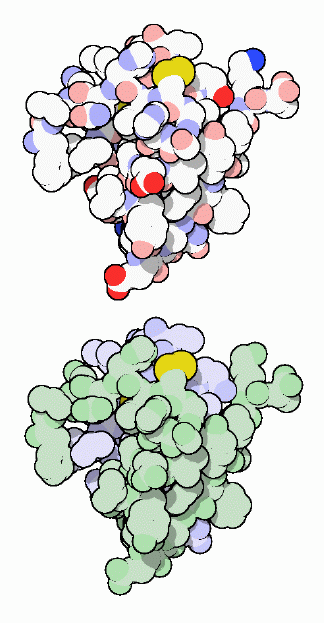|
Inhaltsübersicht | Nanomaschinen | Moleküle | Programme | Kurse | Fun | Links |
||
| > |
Insulin
A Molecular Messenger
Our cells communicate using a molecular postal system: the blood is the postal service and hormones are the letters. Insulin is one of the most important hormones, carrying messages that describe the amount of sugar that is available from moment to moment in the blood. Insulin is made in the pancreas and added to the blood after meals when sugar levels are high. This signal then spreads throughout the body, to the liver, muscles and fat cells. Insulin tells these organs to take glucose out of the blood and store it, in the form of glycogen or fat.
Folding Tiny Proteins
Insulin is a tiny protein. It moves quickly through the blood and is easily captured by receptors on cell surfaces, delivering its message. Small proteins pose a challenge to cells: it is difficult to make a small protein that will fold into a stable structure. Our cells solve this problem by synthesizing a longer protein chain, which folds into the proper structure. Then, the extra piece is clipped away, leaving two small chains in the mature form. These two chains are shown in the lower diagram in blue and green, for insulin from pigs (PDB entry 4ins). The structure is further stabilized by three disulfide bridges, one of which is seen in yellow in each illustration.
Diabetes Mellitus
When insulin function is impaired, either by damage to the pancreas or by the rigors of aging, glucose levels in the blood rise dangerously, leading to diabetes mellitus. For people totally deficient in insulin, such as children that develop diabetes early in life, this can be acutely dangerous. High glucose levels lead to dehydration, as the body attempts to flush out the excess sugar in urine, and life-threatening changes in blood pH, as the body turns to other acidic molecules for delivery of energy. Diabetes mellitus has severe long- term effects as well. It is one of the major chronic diseases in the industrialized world. Lowered levels of insulin that may occur as we age allow elevated levels of sugar in the blood over extended periods of time. Sugar molecules attach to proteins throughout the body, compromising their function, and sugars derived from glucose build up, distorting and clogging cells.
Next: Insulin Therapy
Last changed by: A.Honegger,
